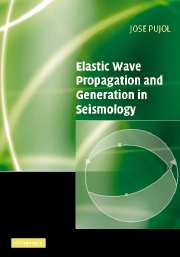Book contents
- Frontmatter
- Contents
- Preface
- Acknowledgements
- 1 Introduction to tensors and dyadics
- 2 Deformation. Strain and rotation tensors
- 3 The stress tensor
- 4 Linear elasticity – the elastic wave equation
- 5 Scalar and elastic waves in unbounded media
- 6 Plane waves in simple models with plane boundaries
- 7 Surface waves in simple models – dispersive waves
- 8 Ray theory
- 9 Seismic point sources in unbounded homogeneous media
- 10 The earthquake source in unbounded media
- 11 Anelastic attenuation
- Hints
- Appendices
- Bibliography
- Index
11 - Anelastic attenuation
Published online by Cambridge University Press: 12 November 2009
- Frontmatter
- Contents
- Preface
- Acknowledgements
- 1 Introduction to tensors and dyadics
- 2 Deformation. Strain and rotation tensors
- 3 The stress tensor
- 4 Linear elasticity – the elastic wave equation
- 5 Scalar and elastic waves in unbounded media
- 6 Plane waves in simple models with plane boundaries
- 7 Surface waves in simple models – dispersive waves
- 8 Ray theory
- 9 Seismic point sources in unbounded homogeneous media
- 10 The earthquake source in unbounded media
- 11 Anelastic attenuation
- Hints
- Appendices
- Bibliography
- Index
Summary
Introduction
The theory developed so far is not completely realistic because it does not account for the observed fact that the elastic energy always undergoes an irreversible conversion to other forms of energy. If this were not the case, a body excited elastically would oscillate for ever. The Earth, in particular, would still be oscillating from the effect of past earthquakes (Knopoff, 1964). The process by which elastic energy is lost is known as anelastic attenuation, and its study is important for several reasons. For example, because attenuation affects wave amplitudes and shapes, it is necessary to account for their variations when computing synthetic seismograms for comparison with observations. Properly accounting for the reduction in wave amplitude was particularly important during the cold-war period because of the use of seismic methods to estimate the yield of nuclear explosions in the context of nuclear test-ban treaties. In addition, because attenuation depends on temperature and the presence of fluids, among other factors, its study has the potential for shedding light on the internal constitution of the Earth. The study of attenuation may also help us understand the Earth's rheology, although the relation between the two is not clear. For a discussion of these and related matters see Der (1998), Karato (1998), Minster (1980), and Romanowicz and Durek (2000).
From a phenomenological point of view, the effect of attenuation is a relative loss of the high-frequency components of a propagating wave.
- Type
- Chapter
- Information
- Elastic Wave Propagation and Generation in Seismology , pp. 357 - 390Publisher: Cambridge University PressPrint publication year: 2003



